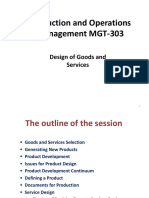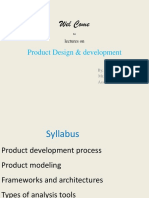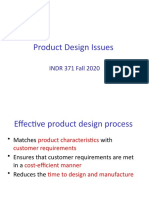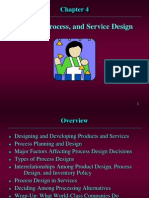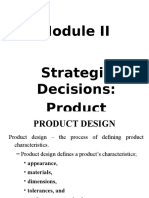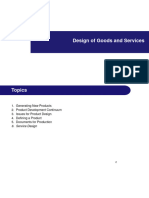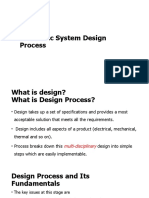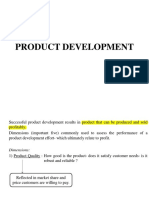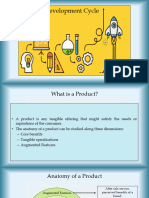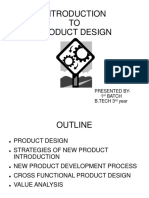30-08-2022
Agenda
BM63009 – Production and Operations Management
To find answers to:
Week 3
• What are product decisions in an organization?
Product Decisions • How to transform an idea into a Product?
• How to translate customer requirements in specific
Sushil Punia
VGSoM, IIT KGP technical attributes of a product?
Aug – Nov 2022
Decision Levels in Operations Management
WHY Design (or Redesign) a Product?
Goals P
P R Drawings 1) To remain competitive
O O • Tap/tackle market opportunities and threats (SWOT)
L Strategies D Product decisions
I U
C C
Specifications
2) Changes in environment:
Y Tactics T i.e. develop and implement a (product) • Political, liability, or legal (e.g., government changes,
strategy that meets the demands of
S the customers/marketplace with a
safety issues, new regulations)
competitive advantage • Economic (e.g., low demand, excessive warranty claims,
the need to reduce costs)
WHY ? WHAT ?
• Social and demographic (e.g., aging baby boomers,
population shifts)
27 4
1
� 30-08-2022
WHY Design (or Redesign) a Product? Key questions for an organization
Before embarking on the products’ journey
2) Changes in environment: Remember: Customers’ want low prices and high
• Technological (e.g., in product components, quality
processes)
• Environmental (e.g. change in material, new 1) Is there a demand for it?
laws) 2) Can we do it? (Capability)
• Competition (e.g., new or changed products or Manufacturability and Serviceability
services, new advertising/promotions) 3) Fit with current offerings?
• Cost or availability (e.g., of raw materials, 4) Does it make sense from an economic (or TBL)
components, labor, water, energy) standpoint?
5 6
If answers are positive! Idea Generation: Sources
Generate Ideas and find answers to 1) From customers or employees
2) From supply chain partners
3) From competitors – reverse engineering
How to transform an idea into a Product?
4) From research and development
Leads to concepts!
2
� 30-08-2022
Feasibility Study Functional Design
Establishing quality level with respect to competitive products
To establish plausibility within the framework of Includes:
organizational goals • Selection of materials
• Process design, etc.
• Market Analysis
Market
• Economic analysis
• Technical analysis
Go for preliminary design, Prototyping, and Testing. Cost Quality
9 10
Image: https://www.bmwgroup.com/en/innovation/design/concepts-and-visions.html
Form Design Production Design
Physical appearance and shape Economic Producibility
Includes:
• Aesthetic features (color, style, etc. )
• Packaging (materials, design, cost, good for shipping)
• More relevant for consumer goods than industrial goods
Includes:
• Simplification – Reduction of design complexity (Low competition)
• Diversification - Increase in Number and variety of products (High competition)
• Standardization – Uniformity (in products/process) and Interchangeability
11
• Other design consideration 12
Image: https://www.bmwgroup.com/en/innovation/design/concepts-and-visions.html
3
� 30-08-2022
Detailed look at Product Designing Process Product Design and Development Process
Customer Research Employee Inventors Distributors Suppliers Ideas
Needs Ideas Ideas Ideas
Market
Feasibility Study
Analysis
Preliminary Design and Prototype
Needs of customers - general specifications
Feasibility Unacceptable Functional Specifications
Study STOP Materials
Dimensions Scope of Form & Prod. Design Scope for
Acceptable
Shapes design and
GO Special features product
CAD Final Design Review engineering
Tolerances
Preliminary Prototyping Surface measures development teams
Design & Testing team Test Market (Pilot)
Simulation
Technical specifications Introduction
Detailed Design
Functional Form Production Evaluation
Drawings
Design Design Design
(Performance) (Physical appearance / shape) (Producibility) Specifications
13 14
Designing for Customer QFD: House of Quality
(4) Interrelationships
(2) How to Satisfy
Design product from the user’s standpoint Customer Wants
(5) Analysis of
Competitors
Integrate customer needs and wants in products (1) What
the (3) Relationship
Customer Matrix
Quality Function Deployment Wants
A formal process to document customers’ wants (6) Importance ratings
(7) Target Technical
Attributes and Evaluation
15 16
4
� 30-08-2022
QFD House of Quality: Example
QFD House of Quality: Example
• Your team has been charged with designing a new
camera for a company.
A House
• The first action is to construct a House of Quality of Quality
(HOQ)
17 18
Measures of Product Development
Success
Time to market
• frequency of new product introductions
• time from initial concept to market introduction
Thanks.
Cost of development process
• number of engineering hours, the cost of materials, and
tooling costs
Quality of products
• product's performance features compared to customer
expectations
19 20


